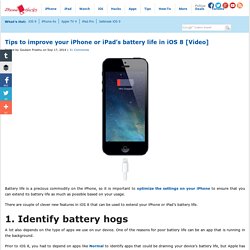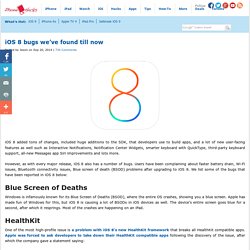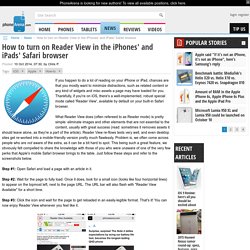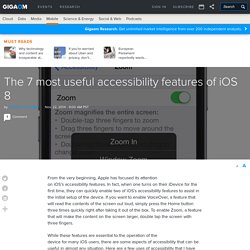

The Most Common iOS 8/8.2/8.3 Upgrade Problems and Solutions. [Last Updated on Sept. 17, 2015] It has been passed about half a year since Apple official released iOS 8, and the iOS 8's adoption is up to 79.45% on March 11th(according to Mixpanel).

Tips to improve iPhone or iPad's battery life in iOS 8. Battery life is a precious commodity on the iPhone, so it is important to optimize the settings on your iPhone to ensure that you can extend its battery life as much as possible based on your usage.

There are couple of clever new features in iOS 8 that can be used to extend your iPhone or iPad’s battery life. 1. Identify battery hogs A lot also depends on the type of apps we use on our device. One of the reasons for poor battery life can be an app that is running in the background. iOS 8 bugs we've found till now. iOS 8 added tons of changes, included huge additions to the SDK, that developers use to build apps, and a lot of new user-facing features as well such as Interactive Notifications, Notification Center Widgets, smarter keyboard with QuickType, third-party keyboard support, all-new Messages app Siri improvements and lots more.

However, as with every major release, iOS 8 also has a number of bugs. Users have been complaining about faster battery drain, Wi-Fi issues, Bluetooth connectivity issues, Blue screen of death (BSOD) problems after upgrading to iOS 8. We list some of the bugs that have been reported in iOS 8 below: Blue Screen of Deaths Windows is infamously known for its Blue Screen of Deaths (BSOD), where the entire OS crashes, showing you a blue screen. HealthKit One of the most high-profile issue is a problem with iOS 8’s new HealthKit framework that breaks all HealthKit compatible apps. Safari File Upload Recovery Mode after OTA update Settings app crash Status Bar bug Extensions Bugs. How to turn on Reader View in the iPhones' and iPads' Safari browser. If you happen to do a lot of reading on your iPhone or iPad, chances are that you mostly want to minimize distractions, such as related content or any kind of widgets and misc assets a page may have loaded for you.

Thankfully, if you're on iOS, there's a well-implemented, robust special mode called 'Reader View', available by default on your built-in Safari browser. What Reader View does (often refereed to as Reader mode) is pretty simple: eliminate images and other elements that are not essential to the content, usually with great success (read: sometimes it removes assets it should leave alone, as they're a part of the article). Reader View re-flows texts very well, and even desktop sites get re-worked into a mobile-friendly version pretty much flawlessly.
Problem is, we often come across people who are not aware of the extra, as it can be a bit hard to spot. 25 Hidden iOS 8 Features You Probably Didn't Spot. Critical Flaws in Apple, Samsung Devices. Normally, I don’t cover vulnerabilities about which the user can do little or nothing to prevent, but two newly detailed flaws affecting hundreds of millions of Android, iOS and Apple products probably deserve special exceptions.

“More specifically, we found that the inter-app interaction services, including the keychain…can be exploited…to steal such confidential information as the passwords for iCloud, email and bank, and the secret token of Evernote,” the researchers wrote. The team said they tested their findings by circumventing the restrictive security checks of the Apple Store, and that their attack apps were approved by the App Store in January 2015. According to the researchers, more than 88 percent of apps were “completely exposed” to the attack. News of the research was first reported by The Register, which said that Apple was initially notified in October 2014 and that in February 2015 the company asked researchers to hold off disclosure for six months. Report.pdf. Doc-0g-8k-docs.googleusercontent. iOS flaw tricks you into giving up your iCloud password.
Successful hack attacks often happen not because of tricky coding, but plain old "social engineering" -- ie, conning people.

A Github researcher called "jansoucek" has discovered an iOS exploit that works on that principal to steal people's iCloud passwords. The latest version of iOS, 8.3, apparently fails to filter out potentially dangerous HTML code embedded in incoming emails. The researcher's proof-of-concept code takes advantage of that by calling up a remote HTML form that looks identical to the iCloud log-in window. It could easily trick someone into entering their iCloud username and password, then hide the dialog after the user clicks "OK.
" More sophisticated folks might be suspicious, since there are differences between a real iCloud log-in and the fake one. Serious iOS bug makes it easy to steal users’ iCloud passwords. A security researcher has published attack code he said makes it easy to steal the iCloud passwords of people using the latest version of Apple iOS for iPhones and iPads.

The proof-of-concept attack exploits a flaw in Mail.app, the default iOS e-mail program. Since the release of version 8.3 in early April, the app has failed to properly strip out potentially dangerous HTML code from incoming e-mail messages. The proof-of-concept exploit capitalizes on this failure by downloading a form from a remote server that looks identical to the legitimate iCloud log-in prompt. It can be displayed each time the booby-trapped message is viewed.
iCloud - Family Sharing. Deep-dive review: iOS 8 packs some snappy new features. It's almost fall again, and so Apple has released the next generation of software that powers its mobile lineup: iOS 8.

As always, this is a free update, and it packs new features and enhancements, both obvious and subtle. The 7 most useful accessibility features of iOS 8. From the very beginning, Apple has focused its attention on iOS’s accessibility features.

In fact, when one turns on their iDevice for the first time, they can quickly enable two of iOS’s accessibility features to assist in the initial setup of the device. If you want to enable VoiceOver, a feature that will read the contents of the screen out loud, simply press the Home button three times quickly right after taking it out of the box. To enable Zoom, a feature that will make the content on the screen larger, double tap the screen with three fingers. While these features are essential to the operation of the device for many iOS users, there are some aspects of accessibility that can be useful in almost any situation.
Here are a few uses of accessibility that I have found to be most useful: Useful Accessibility Features Voice Over for Audible Alerts - Voice Over allows the user to hear what is being presented on the screen.